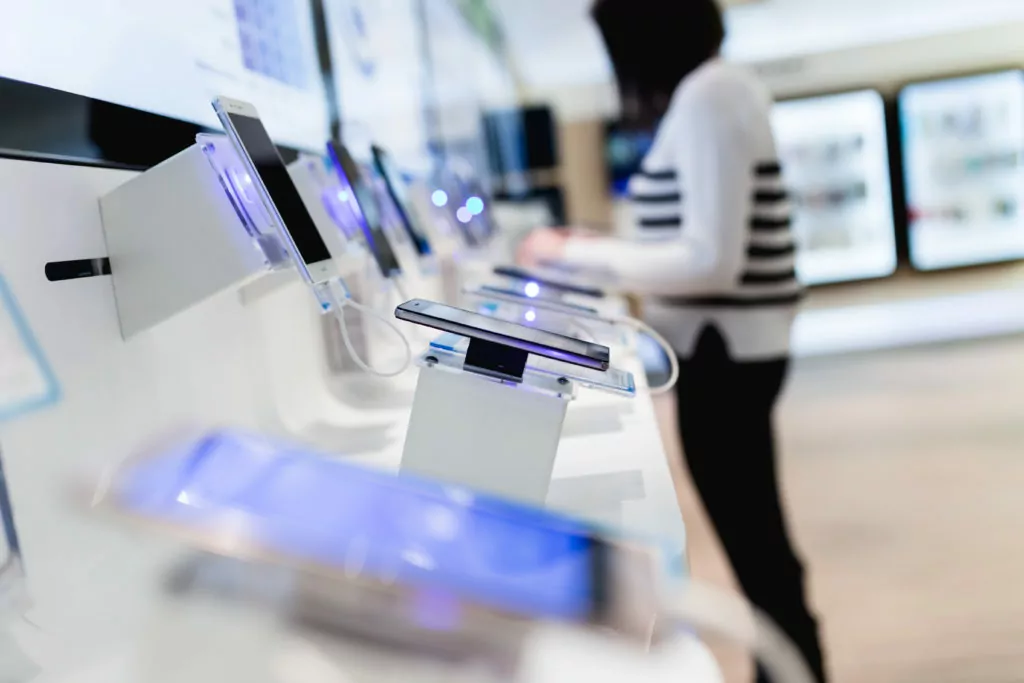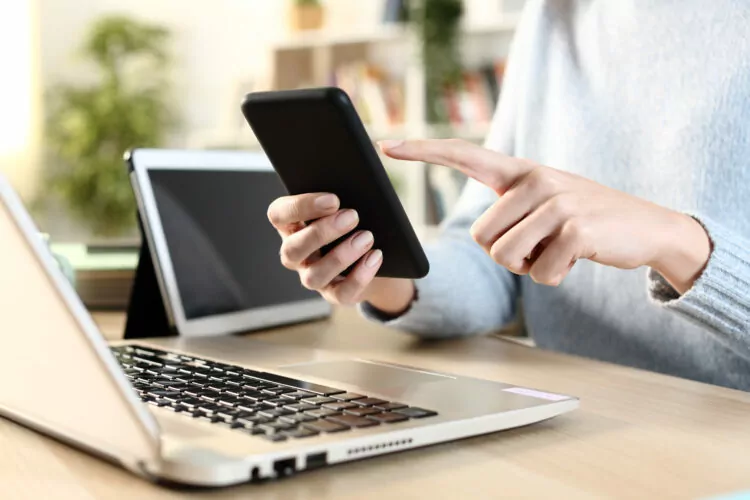Here’s how to bypass a device ban on iOS and Android:
In order to bypass an iPhone device ban, you have to overcome the mechanisms that are denying you access.
This usually involves masking your IP address, MAC address, user account, and IMEI (or MEID) number.
There are several techniques that can do one or all of these things.
So if you want to learn all about bypassing your phone’s device ban, then this article is for you.
Keep reading!
- Why Does My Charger Keep Going On and Off? 6 Troubleshooting Tips
- What is a Lithium Battery? Your Ultimate Guide to Charging and Usage
- Managing iCloud, iCloud Storage Full
- How to Fix an iPhone Not Charging: 9 Awesome Tips
- Why Are My Selfies Backwards on Instagram?
- Do Phones Have IP Addresses: How Hackers Use Them?
- How To Turn Off Location Sharing on iPhone: Privacy Guide
- Call Has Been Forwarded: Meaning?
- Snapchat Takes Up So Much Phone Storage: Why?
- Consumer Cellular Voicemail Password: How to Recover?

What Is a Device Ban?

Before we get into the hows of it all, it’s worth spending a moment to explain the specifics of what it means for an app to ban a device.
This isn’t a hard technical term with a clear definition.
Instead, it’s an impression of a ban based on experience.
So, with any app, you can conceive of having your account banned.
If you use social media, for instance, your account might be banned.
While that comes with its own set of problems, you could theoretically create a new account and then use the app as you see fit.
A device ban would prevent this.
In this case, even though you create a new account, you still can’t use the app on your phone.
Yet, you can conceivably use a new account on a different device.
That’s the real topic today, and it can get a little complicated.
So, we’ll go through each part of it to explain how it works and what you can do about it.
Why Do Apps Ban Devices?

Another piece of information that might help you overcome a ban is understanding why it happens.
Ultimately, app designers and operators have a lot of leeway in how they manage their own software.
While it’s not perfectly true, you can roughly assume that they have the right to ban anyone at any time.
In most cases, apps lay out terms and conditions that users are supposed to follow.
These can be in the form of an End-User License Agreement (EULA), or they can be a less formal set of rules you are expected to follow.
For the most part, if you get kicked off of an app, it is because of the perception that you have violated the rules.
Keep in mind that it’s possible to be banned when you actually didn’t break any rules.
Someone could hack your account and abuse it, leading to a ban.
There are cases where people excessively report someone inappropriately or maliciously, and that can lead to a ban too.
There are other possibilities where your account might be misrepresented in a way that causes an unjust ban.
It’s also possible that your account did, in fact, break the rules.
Ultimately, if you’re trying to overcome a ban, you need to know how they work in order to understand which solutions best apply to your circumstance.
How Do Device Bans Work? (3 Ways)

There are multiple ways that an app can ban a device.
In many cases, the app will implement more than one of these techniques in order to be thorough.
The primary ways this will happen are in the form of an account ban, an IP lock, or a serial number ban (such as a MAC address or IMEI number).
#1 Account Bans

Most apps work in conjunction with an account.
Plenty of apps maintain their own personal accounts (like social media apps).
Other apps simply link up with your Apple ID or Google account that is on the phone.
Accounts offer an easy way for app operators to moderate the user base.
If someone is seen to violate the rules, the account can be banned.
It’s that simple.
You won’t be able to log in with the same credentials.
Now, as mentioned before, this alone does not equate to a device ban.
In theory, you could create a new account, and the app would work.
But, account bans are often paired with device bans for a more thorough approach.
Additionally, if your Apple ID or Google account is what is banned, that represents a greater obstacle for most users.
Do you really want to associate a new master account with your entire phone just for this one app?
That question alone is a powerful deterrent and why many apps include account bans in the process.
It also prevents you from simply logging in with a different device.
You would need a different device and a new account.
It’s more work and thus a stronger form of a ban.
#2 IP Locks

IP locks are where things get more specific to a device.
Every device has a unique IP address that is used to route traffic along the entire internet.
IP addresses work in much the same way as mailing addresses.
They represent a specific location in the world, and the infrastructure uses the IP map to find your device to communicate with it.
The thing with phones is that they move around a lot.
That means that their IP addresses change a lot too.
So, for an app to ban a phone, a single IP lock wouldn’t really get the job done.
Instead, IP locks are almost always used in conjunction with other methods on this list, but we can still cover how the IP lock works.
When an app bans an IP address, it shuts down all traffic to and from the location identified by that IP address.
When that happens, your phone won’t be able to communicate with the app unless the IP address changes.
So, if the IP address used when you are at home is blocked, this ban won’t let you use the app at home.
It can be a nuisance to overcome.
#3 Serial Number Locks

With phone bans, serial numbers are where things get more serious and effective.
Generally, there are two different serial numbers an app could use to try to ban a phone:
- MAC address
- IMEI number
The MAC address is a serial number associated with the component in the phone that allows it to connect to a network.
This number is assigned when the device is manufactured, and it can’t exactly be changed unless you swap out hardware.
Because of this, MAC address bans are significant and more challenging to overcome than simple IP address bans.
But, not all apps need to know your MAC address in order to function.
Because of that, MAC address bans aren’t always applicable.
That’s why you might instead be subjected to an IMEI ban.
The IMEI number is also assigned when the device is manufactured, and the number is used by cell carrier networks to identify your phone on the network.
Without that number attached to your carrier account, you can’t use the carrier network.
So, if an app bans this number, the phone can’t connect to the app using that identification number on a network.
In other words, you can’t use the app with cellular data.
Instead of an IMEI number, the app could also use an MEID number.
While this is technically a different serial number, it serves the same primary role.
For the purpose of this conversation, you can think of IMEI numbers and MEID numbers as interchangeable, even if that isn’t technically correct.
How Do You Overcome a Device Ban? (5 Ways)

No matter how you have been banned, there are always ways around it.
Before we get into them, it’s important to go over a disclaimer.
Depending on why you have been banned, overcoming these restrictions can violate legally binding contracts.
In some cases, you can even be breaking the law with these methods. Use them at your own discretion.
#1 Ask

By far, the easiest thing you can do is contact the app’s support resources to get unbanned.
If the ban is the result of a simple mixup, this is usually easy to do.
Even if you are at fault, you might be able to get the ban lifted or ended early simply by communicating with the people who run the app.
If support is unavailable or unwilling to help, then you can consider other options.
But, remember the disclaimer.
The more you try to overcome this ban, the more you run a risk of violating a legally binding agreement (or unknown legal restriction).
#2 Try a New Account

If your account is banned, you’ll need a new account to use the app.
Even if you get around the other ban methods, the account is fundamental, and in the vast majority of cases, you can assume that your account was banned along with any serial numbers or IP addresses.
As mentioned before, this can be a big deal if the account runs off of your Google or Apple account.
Changing the account on the phone can prevent you from using other apps or services assigned to your established account.
You’ll have to decide if this is worthwhile to you.
#3 Get Another Phone

One thing that makes it easier to use a different master account is getting a different phone for this particular app.
You can leave your old ID on the original phone and use the new ID specifically for the secondary phone that runs the app in question.
You can also get a cheap phone.
A burner phone or a phone without a SIM card can still connect via Wi-Fi.
So you can use the app without having to pay for a second carrier line or account.
It keeps things cheap and easy.
If you do get another phone, it gets around MAC address and IMEI blocking.
The new phone has different hardware and different serial numbers in both of these cases.
The new phone might not overcome IP address blocking, though.
If you connect to the same router with the new phone as the old phone, that IP address might be what is blocked, and that could get in your way, but there are ways around that too.
#4 Spoofing

In light of getting a new phone, you can just trick the blocking software into thinking you’re using a different phone.
It’s less expensive, but it does take a little more work on your end.
For this, you’re trying to mask your real IP address, MAC address and/or IMEI number.
You can try these one at a time until you can use the app again, or you can assume all three are blocked and spoof them from the start.
To spoof an IP address, the easiest thing to do is to use a VPN service.
This is a professional service that is designed to hide your IP address from sites and servers that you connect to.
VPNs are designed to improve privacy and internet security, and you can get free or cheap VPN services that take care of your IP address.
For a MAC address, you can get apps that spoof this number, but in most cases, you have to root or jailbreak the phone first.
Remember that rooting and jailbreaking phones typically void warranties, so proceed with caution.
If you choose this route, there are many apps that can mask a MAC address.
It’s simply a matter of finding one that you want to try.
Spoofing your IMEI number will be similar to spoofing the MAC address.
You can use an app, but you’ll need to root or jailbreak the phone.
If you look around, you might find an app that can spoof both of these numbers at the same time.
Also, we should talk about MEID numbers again.
If you’re going to spoof the IMEI number, you should probably spoof the MEID number too, as either could potentially be used to block your phone.
#5 Use a Proxy

Spoofing can work, but rooting a phone is an undertaking that puts the phone at risk.
An easier way to go about this (at least potentially) is using a proxy.
With this technique, you connect your phone to a computer.
It can be a laptop, desktop, or just about anything else.
You can set that computer up as a proxy server.
So, what happens is the proxy device acts as a middleman when you connect the phone to the internet.
Any traffic goes through the proxy first, so its MAC address and other serial numbers are used for communication.
Basically, the app can’t tell that you’re using your phone, so any block specific to your phone won’t work.
Since IP addresses can be blocked at your router instead of your phone, you might also need to use a VPN with the proxy server.
- Why Does My Charger Keep Going On and Off? 6 Troubleshooting Tips
- What is a Lithium Battery? Your Ultimate Guide to Charging and Usage
- Managing iCloud, iCloud Storage Full
- How to Fix an iPhone Not Charging: 9 Awesome Tips
- Why Are My Selfies Backwards on Instagram?
- Do Phones Have IP Addresses: How Hackers Use Them?
- How To Turn Off Location Sharing on iPhone: Privacy Guide
- Call Has Been Forwarded: Meaning?
- Snapchat Takes Up So Much Phone Storage: Why?
- Consumer Cellular Voicemail Password: How to Recover?

